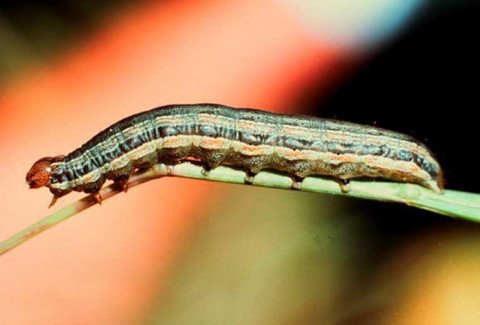
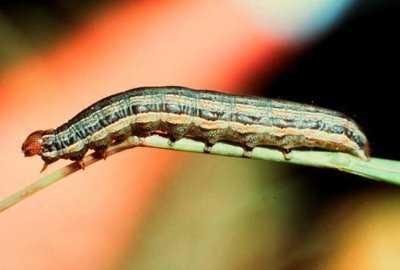
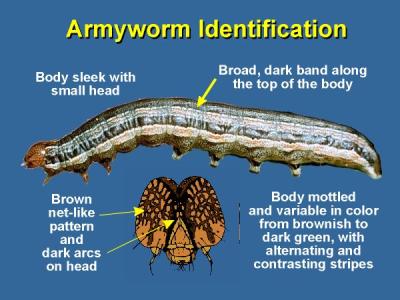
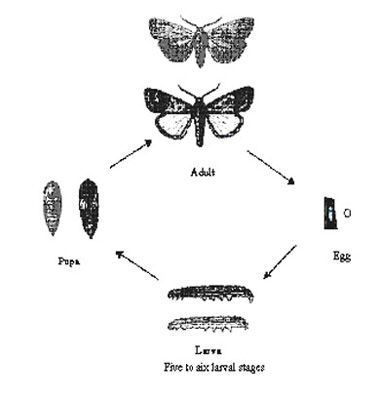
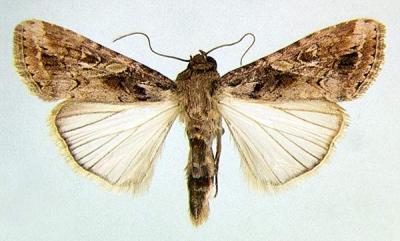
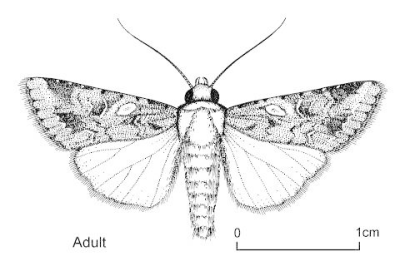
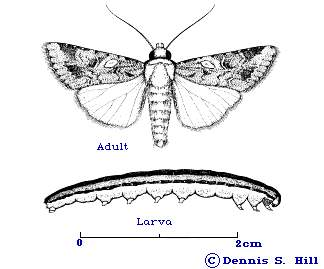
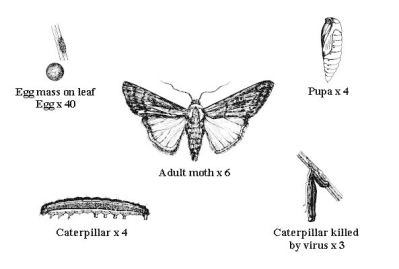
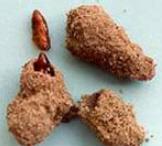
The annual cycle of he african armyworm in eastern and southern Africa
(Source CABI_Biology and Ecology) In Eastern Africa, the rains are associated with the passage of the Inter-Tropical Convergence Zone (ITCZ) which moves northwards and southwards seasonally, moving over northern Sudan and the southern Arabian Peninsula in July to August, southward through Ethiopia and Somalia during October, across Kenya during November, and reaching Tanzania by December and as far south as northern Mozambique and Zimbabwe in January. During February and March, it moves north through Tanzania, crossing Kenya in April and May and southern Sudan, Ethiopia and Somalia in May to June, to reach western Arabia by July. The southward movement of the ITCZ is associated with the 'short rains', and the northward movement with the 'long rains', in southern Ethiopia, Somalia, Kenya and northern Tanzania. Regions at the extremes of its traverse usually have only one rainy season.During the dry season, grasses dry out over most of eastern Africa, becoming unsuitable for larval development. However, populations persist where host plants continue to grow, for example, where there is intermittent rainfall through this period. In the absence of concentrating weather systems, these populations remain at low densities in the solitarious form. In eastern Africa, dry season populations have been detected in Malawi, western Uganda, on the shores of Lake Victoria and in highland areas, and probably most importantly, in coastal regions of Kenya and Tanzania. Similar areas presumably support dry-season populations elsewhere in Africa. These populations are the source of moths initiating the first outbreaks of the subsequent rainy season.First outbreaks typically occur in Kenya and Tanzania where there are two rainy seasons. They are associated with the first rainstorms of the short rains which tend to occur on the eastern side of high ground where moths, flying from coastal source areas on the dominant easterly winds at this time, meet storm-induced wind convergence. These 'primary' outbreaks, derived from low-density populations, are distinguished from subsequent 'secondary' outbreaks which are initiated by moths originating from earlier outbreaks. Outbreaks (usually primary) leading to significant sequences of secondary outbreaks are termed 'critical'. The sequence of outbreaks that occurs seasonally follows the pattern of seasonal winds. In eastern Africa, outbreaks move progressively westwards from eastern Tanzania and Kenya, in some years as far as Burundi, before the start of the major northward movement with the passage of the ITCZ through Kenya and Uganda, Ethiopia, Somalia and southern Sudan, in some years reaching the Yemen. In southern Africa, the spread of outbreaks seems to originate in southern Tanzania, northern Mozambique and Malawi, moving into Zimbabwe, Swaziland and South Africa, with less frequent invasions of Zambia and Botswana.The extent and severity of outbreaks appears to depend largely on the successful development of primary outbreaks at the start of the rains. This has been shown to be associated with preceding drought, frequent early storms to concentrate flying moths and initiate flushes of grass growth, and dry and sunny periods during the larval stages to promote survival and rapid development. Therefore, major upsurges occur in seasons of sporadic rainstorms and long sunny periods throughout the outbreak period. Prolonged cool, cloudy and rainy weather in the short rains is associated with high larval mortality, particularly from viral disease, and suppresses the development of subsequent outbreaks.With its rapid development, high reproductive capacity, and mobility by migration, S. exempta is well adapted to exploit the highly seasonal and ephemeral habitats provided by the rain-induced growth of host plants in tropical grasslands.This account is based on extensive, long-term studies in East and southern Africa. Very little is known of the biology and ecology of S. exempta elsewhere in its range. See Rose et al. (1996) and references therein. Rose DJW, Dewhurst CF, Page WW, 1996. The African armyworm handbook. Nairobi, Kenya: Desert Locust Control Organisation for Eastern Africa.
Comments for REVIEW
Comments mh, 10.6.09 Header: Pls check pestmodule texts/description for all hosts: Millet, Teff (there is nothing), Rice, Carrot, Sweet Potato (exchange image and Description to S.exigua on Sweet potato), Sorghum and Maize, so that they all contain a complete description and a 'what to do'. Pls extend host list if necessary so that all crops that are presented on infonet - whenever they are hosts of Armyworm - appear in the header. (what about sugarcane, wheat, (pasture grasses Cynodon and Pennisetum species), cotton, tea.???) Images: Pls search photograph of egg and young larvae, pupae and jung green caterpillar, as well as of solitarius and gregarius form. Text: Pls introduce info on S.exigua and describe differences to S.exempta. (An image of S.exigua is on peas and on soybean). Habitat management: shouldn't it be when the temperature is decreasing that eggs are laid? (instead of temperature 'rise') The meaning of the viruses chaptre under natural enemies is a bit unclear. Can they be bought, where? otherwise what is the meaning of this information? For neem, Bt and pyrethrum, more detailled recipes must be included: the information provided is not specific and to general: we need to know recipe against s.exempta, how to use, when, against which life cycle stadium, dosage, intervall etc. instead of only linking to the Neem, Pyrethrum and include under Bt datasheets, i.e which strain/product (Bt). Bt: pls include dosage (few tablespoons vinegar in a gallon? of water) Biopesticides: should it mean: biopesticides should be applied if larvae are 'below' threshold levels? (instead of 'at or above threshold) Neem: I dont understand the second sentence (why 'although'?) - I think there is a word missing. Traps: pls let me know where under traps to include the 'tripod'. I will also leave the information here. Light trap: it shold be explained, how moths can be identified, how a light trap works and how many moths must be captured to know whether there is an invasion, otherwise the information is not useful. Include reference adresses for all products promoted on this page, under the button 'Reference Adresses'. (in Kenya and if available also for other African countries)
Spodoptera exempta, Laphygma exempta
